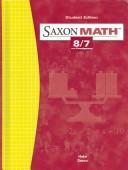Check nearby libraries
Buy this book

Pre Algebra student edition
Saxon Math 8/7 is designed for students in grade 7, or for 8th grade students who are struggling with math.
Saxon Math Homeschool 8/7 teaches math with a spiral approach, which emphasizes incremental development of new material and continuous review of previously taught concepts.
Building upon the principles taught in Saxon Math 7/6, the Saxon 87 textbook reviews arithmetic calculation, measurements, geometry and other skills, and introduces pre-algebra, ratios, probability and statistics. Students will specifically learn about adding/subtracting/multiplying fractions, equivalent fractions, the metric system, repeating decimals, scientific notation, Pi, graphing inequalities, multiplying algebraic terms, the Pythagorean Theorem, the slope-intercept form of linear equations, and more .
Lessons contain a warm-up (with facts practice, mental math, & problem-solving exercises); introduction to the new concept, lesson practice exercises where the new skill is practiced, and mixed practice exercises, which includes 25-30 old and new problems. In-depth "Investigations" are provided every 10 lessons, and have their own set of questions.
Check nearby libraries
Buy this book

Previews available in: English
Showing 6 featured editions. View all 6 editions?
| Edition | Availability |
|---|---|
|
1
Saxon Math 8/7: Home School Student Text
April 2004, Saxon Publishers
Paperback
in English
- 3 Student edition
1591413206 9781591413202
|
zzzz
Libraries near you:
WorldCat
|
|
2
Saxon Math 8/7 (Student Edition)
January 2004, Saxon Pub
Hardcover
in English
- 3 edition
1565775090 9781565775091
|
aaaa
Libraries near you:
WorldCat
|
|
3
Saxon math
2004, Saxon Publishers, Saxon Pub, SAXON PUBLISHERS; 3rd edition (2004), Saxon Publishers, Incorporated, SAXON PUBLISHERS, Saxon, Brand: Saxon
in English
1591412978 9781591412977
|
zzzz
Libraries near you:
WorldCat
|
|
4
Saxon Math 4 Student Woorkbook Part 1 (Part 1)
2004, Saxon
Paperback
in English
156577454X 9781565774544
|
zzzz
Libraries near you:
WorldCat
|
|
5
Saxon Math K Student Workbook Material
April 30, 2003, Saxon Pub
Paperback
in English
- 2 edition
1591412978 9781591412977
|
zzzz
Libraries near you:
WorldCat
|
| 6 |
zzzz
Libraries near you:
WorldCat
|
Book Details
Table of Contents
The Physical Object
ID Numbers
Community Reviews (0)
Feedback?| June 24, 2024 | Edited by ditchqueen | Edited without comment. |
| January 5, 2023 | Edited by ditchqueen | Edited without comment. |
| January 5, 2023 | Edited by ditchqueen | Edited without comment. |
| February 28, 2022 | Edited by ImportBot | import existing book |
| December 10, 2009 | Created by WorkBot | add works page |












